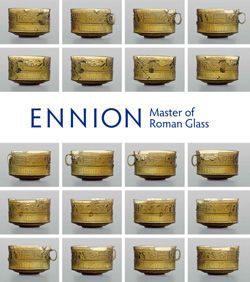Glass hunt-and-scroll bottle
Translucent blue green; handle in same color.
Everted fine rim, folded over and in; flaring mouth; short concave neck, splayed at base and merging with piriform body; flat bottom; handle trailed over rim and top of neck and drawn upwards; continuous mold seam runs from neck, down side, and across bottom, with two distinct vertical creases in relief on neck, and bottom divided into two levels by misaligned mold.
On body, decoration in relief in three registers, separated by two horizontal rows of knobs: at top, large dog (or lion) with long tail, facing right, crouching on forepaws on one side of mold and a deer standing facing right with head erect on the other side, flanked by a slender tree to left and a curving tendril to right; center, two wavy tendril scrolls with berries divided by a broad palmette on one side and a slender lotus bud on the other across the mold seams; bottom, twenty-one upturned flutes, two of which overlap at junction of mold.
Broken and repaired, most of handle missing and some small loses in lower body and bottom; few pinprick bubbles; patches of creamy brown weathering and iridescence.
The decoration on this and another similar flask (17.120.243) resembles some elements on the glass vessels signed by Ennion, notably the floral scroll, the flutes, and the horizontal rows of dots, but it also includes animals in relief, which are not part of his standard repertoire. The handle, of which only the top remains, marks the flask as belonging to the so-called 'floating handles' group of mold-blown vessels that were made in a number of different designs.
Due to rights restrictions, this image cannot be enlarged, viewed at full screen, or downloaded.


